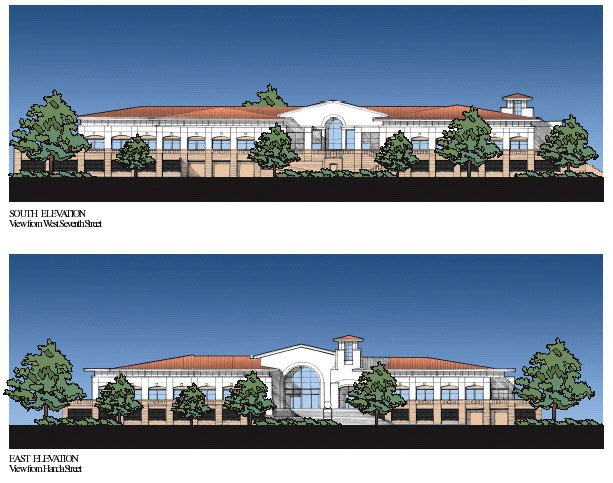GILROY
– Fresh off a visit to the future, $10 million Morgan Hill
police headquarters, City Councilmen Bob Dillon and Russ Valiquette
are defending Gilroy’s controversial $26.7 million police station
project.
GILROY – Fresh off a visit to the future, $10 million Morgan Hill police headquarters, City Councilmen Bob Dillon and Russ Valiquette are defending Gilroy’s controversial $26.7 million police station project.
Both men Wednesday called the Gilroy station a “good deal” for the city, especially when comparing it to the already-built, industrial park building Morgan Hill police will eventually call home.
Valiquette and Dillon say the comparison between the two, which for weeks has been the focus of newspaper editorials and reader letters, is “apples to oranges.”
Gilroy will get a police headquarters that from day one will meet law enforcement needs and in the future will be ground zero for the civic center expansion and overhaul. Morgan Hill will take over a building that needs to go through serious retrofitting and sits more than a mile away from the downtown civic center.
“They already realize they’re going to have headaches with it,” Valiquette said. “We’re getting a better deal.”
The councilmen’s comments trailed a Wednesday night community briefing on the redesign of Gilroy’s new police station.
The redesign cut $5.4 million off construction costs that in June 2003 came in $8 million above original projections and nearly $7 million above the city’s construction budget.
Wednesday’s session, which was held at City Hall, gave city and police officials a chance to explain the complex and controversial history of the fledgling project to the public. It also gave residents a chance to ask questions about the facility, its costs and its impacts to the community.
“Put us through the rigor. Grill us. Give us an opportunity to see if we can stand the test,” Assistant Chief of Police Lanny Brown told a small and subdued audience Wednesday.
Only four residents came to the session last night and none of them were overly critical of the city’s costly effort to build the two-story, 105,000-square-foot facility. For the DeLeon family, whose Carmel Street home will neighbor the new station, the cost of the station was hardly an issue.
“We came here to learn more about how a building of this size is going to make the neighborhood look and how it might effect the value of our home,” Teresa DeLeon said.
DeLeon also had concerns about safety given the larger jailing facility that will be on the site.
“I feel better now,” DeLeon said.
Brown said new square-footage requirements for inmates will not allow Gilroy police to hold more temporary prisoners at any one time. The GPD can hold 22 prisoners temporarily.
Brown also explained that serious criminals would be entering and exiting a section of the station separate from the area most of the public will use to conduct its business.
Thomas Muniz, who also attended, had concerns over the eye-popping cost, but left satisfied.
“What I see here is pretty much (the city has) done its diligence to reduce costs,” Muniz said.
Brown said he wished more people had come to the session, but was not discouraged by the low turnout. The longtime Gilroyan said, based on Wednesday’s turnout and on conversations he’s had with people around town, most people realize the costs are being covered by developer impact fees and will not directly hit their wallets.
“I think it would be different if the city were creating some kind of new tax,” Brown said.
Valiquette agrees.
“I think what has gotten lost in the media is that the costs are being paid by police impact fees,” Valiquette said. “This is money we have earmarked for police. This can’t go to the fire department. This can’t pay for maintenance.”
Valiquette said he would support using new police impact fees to cover the amount that may still go beyond budget.
“I’ll be dammed if we take money out of another program in town to pay for the station,” Valiquette said.
City officials also used Wednesday’s session to remind the public that the station is part of an overall Civic Center upgrade that will meet the needs of a nearly 70,000 Gilroy population 20 or so years from now. It will expand City Hall, build a new senior center, improve the library and potentially create more space for some fire department operations.
Also, some of the costs now associated with the police station construction – for instance, installing new water lines – will factor into future Civic Center work.
Having a police station as part of a Civic Center – rather than in an industrial complex like Morgan Hill – has more than financial benefits, officials say. Administrative efficiency between city departments improves.
“I like the idea of a (Civic Center) campus,” Dillon said. “I think it has an aesthetic appeal that makes sense.”
Even if the ideal, cheaper industrial site emerges in the near future – something Brown said he has looked for and cannot find – it’s unlikely the city would change its plans. It has already purchased the Hanna Street land where the station will go.
Brown and Bill Headley, the city’s facilities manager, spent some of the hour and a half session hoping to debunk the Taj Mahal myth. Critics of the police station scoffingly called the facility Taj Mahal Jr. when plans for a communications clock tower, tiled floors and a running track were at some point proposed. All of those amenities have been stripped from plans in the new no-frills version, Brown and Headley said.













